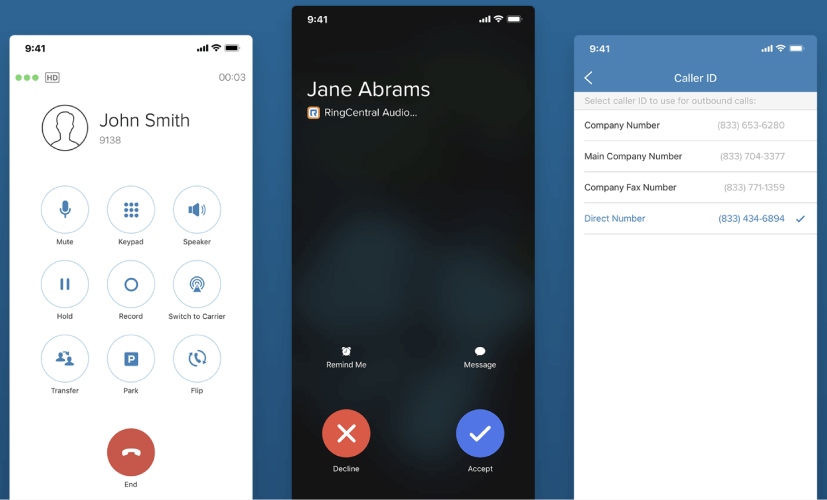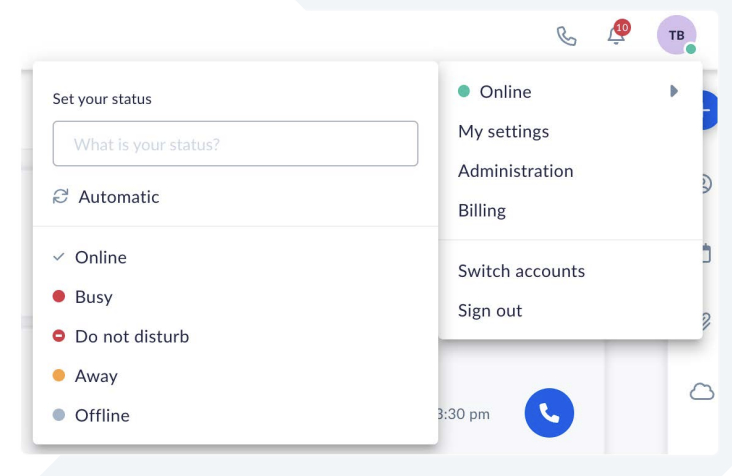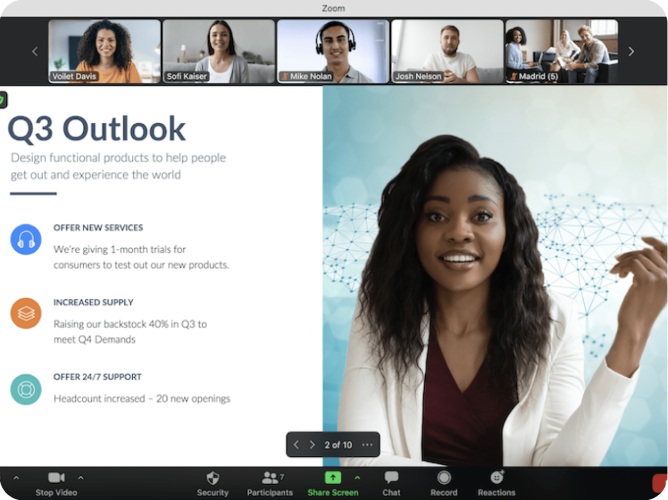Session initiation protocol (SIP) is a set of rules for controlling real-time communication sessions over the internet. Sessions include multimedia exchanges like voice calls, video conferencing, and instant messaging between two or more devices. SIP forms the foundation of voice-over-internet-protocol (VoIP) and enhances network reliability. In this article, we uncover what a session initiation protocol is and its role in facilitating business communications.
How SIP Works
SIP protocol works by establishing the connection between two or more computer systems and manages the parameters for direct media communications. It follows a request-response model where a series of back-end messages are exchanged to establish, manage, and terminate communication sessions. Let’s take a deeper look at what a SIP protocol is and how it works.
- User initiation: When a user initiates a voice or video call, their device sends a SIP request to the recipient’s device, which includes the user’s IP address. The request uses the session description protocol (SDP) to convey the parameters of the communication session.
- Server processing: The pending request is then forwarded to the recipient’s SIP server, which transmits the request to the recipient’s device for processing. A SIP service comprises the proxy, registrar, and redirect server. The proxy server is responsible for routing SIP requests to the recipient.
- Session acceptance: Once the recipient’s device receives the request, the user can accept, redirect, or reject the session. If accepted, a SIP session is established between the initiating and receiving devices, thereby facilitating real-time communication.
- Session management: SIP continues to control the session, granting users the ability to modify or end it as necessary. For instance, a SIP call allows the user to mute, add participants, or disconnect the call.
Whenever a server receives a request, the software issues a receipt back to the sender. Responses undergo coding based on their message, with specific meanings assigned to a three-digit format. For example, a 180 response code means the recipient’s device is ringing. This communication exchange occurs within seconds, involving all the participants in the call.
Key Functions of SIP
SIP is a versatile network protocol that handles various media applications, allowing companies to improve their communication experience. To better explain the definition of session initiation protocol, we explore its functionalities and use cases below:
VoIP
VoIP is often confused with SIP, but they are not the same. The difference between VoIP and SIP is that VoIP controls voice calls, while SIP controls all media types. So, what is the purpose of SIP in VoIP? SIP enables VoIP to transfer various forms of media, such as voice, text, videos, and files.
SIP functions as a signaling protocol in VoIP systems by establishing voice calls over the internet. VoIP doesn’t necessarily need SIP to function, but adding SIP to a VoIP framework significantly enhances its capabilities.

RingCentral lets you manage your phone system directly from your mobile device. (Source: RingCentral)
RingCentral, the leading provider of VoIP solutions, uses SIP to facilitate calls over the internet and deliver robust VoIP features to facilitate seamless call distribution. A session initiation protocol example using VoIP is the process of routing calls to the appropriate destination based on the caller’s preferences and agent availability.
SIP Trunking
SIP trunking is the method of sending and receiving communications over the internet through private branch exchange (PBX) equipment. It replaces traditional phone lines by upgrading your PBX to an internet-based phone network. Through this technology, your on-premise phone system benefits from unified communications services like video conferencing and instant messaging.
Fundamentally, SIP trunking transforms VoIP phone systems without requiring a large upfront investment. SIP trunks’ internet-based solutions make them more reliable, flexible, affordable, and scalable compared to traditional telephone lines. This makes SIP trunking a useful transitional technology for scaling companies wanting to control their telecom spending.
User Presence
A SIP protocol provides presence information so users can set their availability status and see if their coworkers are available to communicate in real time. Presence indicators typically include options whether a user is active, busy, away, or offline. Most communication apps attribute these statuses to color icons like green, red, and orange.

Nextiva provides users the option to modify their online availability manually. (Source: Nextiva)
Nextiva is a cloud-based business phone provider with a team presence feature where users can adjust their availability and instantly view the status of their coworkers. This facilitates efficient communication as users can set their status offline if they want to focus on their work and find the appropriate time to contact their team members.
Video Conferencing
SIP extends a VoIP system’s calling capabilities through back-and-forth transmission of audio and video data in real time. It establishes video communication over a high-speed internet connection and allows users to add and remove participants wherever they’re located.

Zoom allows the use of slide presentations as a virtual background. (Source: Zoom)
Zoom is a well-known video conferencing software that uses SIP to initiate sessions between multiple video participants. Video meeting apps deliver a wealth of video collaboration tools, such as whiteboard, screen sharing, and co-annotations, to facilitate remote collaboration.
Instant Messaging
SIP uses the MESSAGE method, a type of SIP request that allows the transfer of instant messages between users. Similar to voice and video calls, the SIP protocol verifies users before connecting them. It also sends receipts if the recipient has received the message and indicates when the other party is actively typing. Instant messaging either takes place in a standalone chat app or is integrated into a video call.

Dialpad lets you chat with multiple users in a single conversation. (Source: Dialpad)
Dialpad, an artificial intelligence (AI)-powered phone service, offers a digital workspace where users can have group conversations, share files, and start team channels. This simplifies business communications as most VoIP providers allow users to call or host meetings from any message thread.
Benefits of SIP
SIP-based communications offer cost-savings, flexibility, and mobility advantages to companies looking to replace their on-premise phone system. Let’s take a closer look at what SIP can do for your organization.
- Greater mobility: Since SIP is embedded into cloud-based software, remote teams can access the same communication tools in the office regardless of location. Users can make calls from anywhere using any device connected to the internet. Plus, the flexible nature of SIP makes it easier for businesses to reach customers in foreign markets without having a physical office.
- Easy setup and accessibility: SIP platforms are easy to implement because they completely operate in the cloud. It utilizes the internet so all you have to do is download the app and start making calls. All conversations are stored in the cloud, so you can access your data from any device.
- Affordable and low maintenance: SIP applications are available for free or at a small subscription cost. There are no setup or maintenance fees involved because they are often managed remotely by the service provider who handles all the infrastructure support. SIP providers charge on a monthly per-user basis and offer discounts for annual plans and volume purchases.
- Feature-rich and supports multiple channels: SIP provides businesses with several ways to reach clients on their preferred channels, whether via voice, video, or chat. When it comes to internal communications, employees are able to communicate in real time, creating a seamless collaboration experience across the team. SIP users also enjoy a wealth of advanced features, specifically for managing call volumes.
Frequently Asked Questions (FAQs)
A SIP session is a pathway between two or more endpoints exchanging communication data, such as voice call, instant chat, or video conferencing. It is controlled by SIP protocol and involves signaling mechanisms that initiate, modify, and terminate multimedia sessions between users.
Yes. SIP is equipped with various security features to safeguard data and communication sessions against unauthorized access. Many SIP providers use security protocols, such as secure real-time transport protocol (SRTP) and transport layer security (TLS), to encrypt media content. It is also equipped with user authentication mechanisms to ensure only authorized users have access to confidential data.
SIP relies on a high-speed internet connection to facilitate real-time media communications, including VoIP calls and video conferencing. This puts significant pressure on your bandwidth, potentially affecting other SIP users on your network.
Bottom Line
Understanding session initiation protocol is essential for assessing your business’ cloud communications strategy. SIP enables VoIP and multimedia sessions over the internet by exchanging voice calls, video, and instant messaging. If you want to experience greater cost-savings and the feature-rich offerings of SIP, make sure to select a SIP-enabled platform that supports your existing business needs and budget.